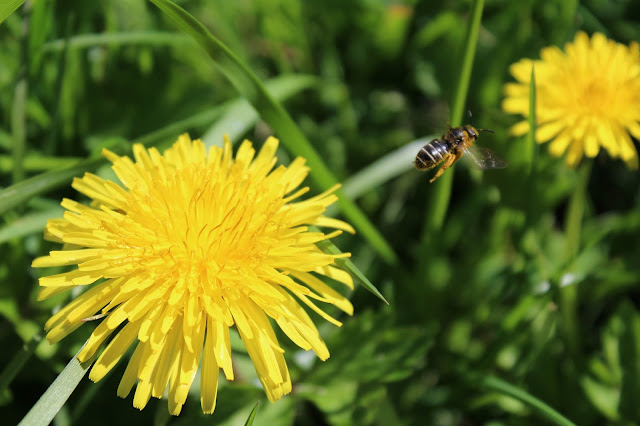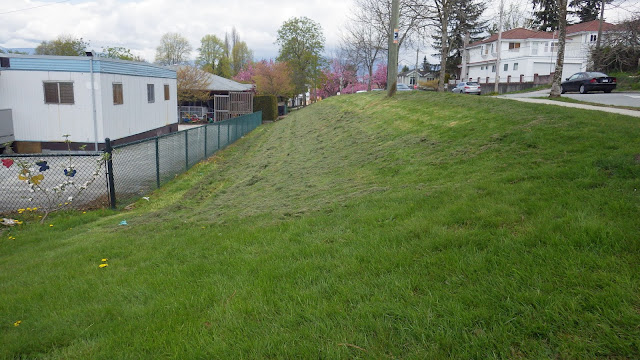As I sit on a rock in the Tupper Greenway during lunch hour, the peace is disturbed by a Vancouver School Board gardener with a leaf blower. He is creating a toxic dust storm uncomfortably close to a group of students who are eating their lunch. Why does the VSB need leaf blowers? They cause noise and air pollution and do not accomplish anything useful in a garden. A pox on leaf blowers, I say! They will be getting a letter from Madame Beespeaker.
As you can see in the photo above, forget-me-nots and Kanazan ornamental cherries are blooming in the hood. Those tiny self-seeding forget-me-nots can actually provide important food for small bees at this time of the year when not much else is blooming at that height. Flowering brassicas also provide food for mason bees now, so those are two plants you should really have around to make sure your strawberries and fruit trees and shrubs are getting pollinated too. It may seem counter-intuitive to have a variety of plants blooming that may draw bees away from your food plants, but actually I believe that you will attract more species of bees to your garden, in greater numbers, which means they will be pollinating every bee plant in sight or smelling distance of their nests right now.
The Tupper Greenway is a beautiful pollinator corridor that arose after a tragic event near the high school. Students and staff rallied with the community to create a place of healing and regeneration. I have seen an incredible transformation of this space. One of the best things that has happened is that this is a safe place for children to learn to ride bikes and the Pedalheads school use it over many weeks of the summer to help fledgling cyclists. Families feel safe here and students eat their lunch among the fragrant flowers of red-flowering currants. The Master Gardeners have helped to provide the know-how and the local community provides the social capital of volunteer hours to keep the garden beautiful.
Two years ago I noticed there was an aggregate of ground-nesting bees right beside the high school on the Northeast side of the "B Wing". (I'm not making that up!!!!) Hundreds of bees, cuckoo bees, and wasps fly back and forth from flowers to the nesting holes when the sun warms the soil and the air.
One of these bees is a common sweat bee Halictus rubicundus.
She lacks the facial fovea or what I call "sideways eyebrows" that would identify her as an Andrena mining bee.
She has a kind of "false stinger", a line at the back of her abdomen. These bees are gentle, and do not sting.
Biologist and educator Erin Udal has an affinity for ground-nesting bees. She is an ace at finding nests wherever we go. We spent our lunch hour photographing the bees in the ground and in the dandelions nearby where they are voraciously drinking nectar and covering themselves in the neon orange-yellow pollen.
Here you can see the displaced mud around the edges of the hole. It looks like she's created quite a deep hole. This generation of bees is re-using the nesting site they emerged from.
Another species of smaller bee was collecting another kind of light-coloured pollen--perhaps from fruit trees nearby.
This sloped, scrubby lawn is a paradise for ground-nesting bees. The gardeners have avoided mowing it. I wonder if we should mark it in some way so it doesn't get destroyed, especially while the bees are above ground for the 4-6 weeks they are active at this site. Those little dots of light in the air are all bees.
In this species (I'm not sure which one), the males are smaller than the females and have a yellow clypeus on their face.
There are two patches of dandelions within metres of the nesting site which are busy with these little bees. They are on the sloped sides of the fields where the lawnmowers can't reach. Or so I thought.
Some of the best friendships I've made are with people who love being with bees as much as I do. We form bonds over the simple pleasure of being with bees.
As you can see in these photos the branched hairs of the bee pick up the pollen grains of the dandelions.
Would you deprive this beautiful bee of her dandy diet?
This bee even has pollen on her antennae, so she will stop and groom it, using special notches in her legs.
These small bees tolerate each other's presence on the same flowers. When it gets crowded, they simply move to another flower. They methodically circle around the dandelion, creating all those beautiful seeds we can make wishes upon.
The science teacher and I have been taking the students out to show them the nesting sight and the bees. Then this happened. The VSB gardeners mowed down the bee food!!!!!! This is why all levels of our ground care systems need to be educated about ground nesting bees.
This weekend I spotted this on a Vancouver private lawn and I thought--"Hey, maybe this is what we need to do to protect ground nesting bees while they are active.
Of course, these folks were just protecting the area while trying to reseed the grass. It has likely Good luck with that. Or should I say" bad luck with that." Furthermore, pesticides to kill chafer beetle larvae containing neonics are now banned in Vancouver because they kill ground-nesting bees and poison the soil. For more info, check out the Xerces guide to avoiding neonics in your garden here: http://www.xerces.org/wp-content/uploads/2013/06/NeonicsInYourGarden.pdf
The sloped areas at the school with the nests and the dandelions need to be protected. Also, that site where the dandelions were mowed would actually be a great place to expand the Tupper corridor with a bee meadow. Let's do it!
Erin Udal and I are working with Tupper art and science students on a project funded by ArtStarts, Tupper PAC, Tupper School, and the Riley Park Community Garden. We thank them all for their support.



























No comments:
Post a Comment